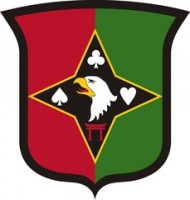Written by Sgt. 1st Class Pete Mayes
101st Sustainment Brigade

 Bagram Air Field, Afghanistan – Soldiers with the 101st Sustainment Brigade teamed up with the Boeing Company and USTRANSCOM one year ago to train and test out a new vehicle recovery system that would be fielded in Afghanistan.
Bagram Air Field, Afghanistan – Soldiers with the 101st Sustainment Brigade teamed up with the Boeing Company and USTRANSCOM one year ago to train and test out a new vehicle recovery system that would be fielded in Afghanistan.
The Joint Recovery and Distribution System, a flatbed trailer intended to load heavily damaged vehicles and bring them back to base, were tested and re-tested by 14 Soldiers assigned to the brigade’s Support Operations team during a two-week training back at Fort Campbell.

“All the hydraulics works a whole lot better than they did back at Campbell,” said Sgt.1st Class Brian Twitty, wheel maintenance supervisor, 584th Maint. Co., 17th CSSB, 101st SB. “On the backside of the trailer, you’ve got something that allows you pull something off the side of the trailer at a 90 degree angle.”
The Lifeliners began training on the new JRADS system in April 2010, spending two weeks on the post’ back 40 learning the intricacies of the new equipment. The Soldiers, some of them Iraq veterans, had definite ideas on how the equipment could be better fielded in a combat environment.
The team was conducting, “snatch and pull” training, which consisted of hooking a damaged vehicle to the JRADS and using the winches to pull it onto the flatbed.

“It’s exactly what it sounds like,” said Chief Warrant 2 Dietor Speaks, maintenance technician for the 584th Maint. Co., 17th CSSB., 101st SB. “Just hook it up to a trailer, snatch it, and get out of danger.”
Speaks, who will lead the JRADS team missions for his company, was not part of the brigade when the first JRADS training was conducted, and is learning the system for the first time. He said he did vehicle recovery back in 2003 while deployed to Iraq.
“Before, all we had was a wrecker. Now we’ve got this thing that can pull anything out of anywhere,” he said.
The new and improved JRADS system can lift vehicles with missing or damaged wheels or axles, as well as overturn and recover vehicles parallel to it. It can also transport vehicles over rough terrain, which is essential in Afghanistan.
Many of the changes that were made to the JRADS dealt with minor issues, such as adding retractable steps to allow the Soldiers to climb up the trailers.
Spc. Daniel Bulles, wheel vehicle mechanic with the 584th Maint. Co., 17th CSSB, 101st SB, also took part in the training back at Fort Campbell this past year, and is getting a re-fresher on everything he learned.
Bulles said he didn’t offer a lot of advice for the new Soldiers learning the JRADS. “I just let them do their job and learn on their own,” he said.
He said he also noticed the minor improvements made to the vehicle. “The winches are better, extra VI boxes … they fixed a lot of the problems.”
Gary Noah, JRADS field support representative for Boeing, said his company and USTRANSCOM took to heart all of the issues the Soldiers mentioned to them last year on improving the vehicle.
“We looked at a lot of their recommendations, and added quite a few of them,” he said. “The Soldier input is invaluable. They’re the ones who have to use it every day on mission, so we hold their opinions in high regard.


